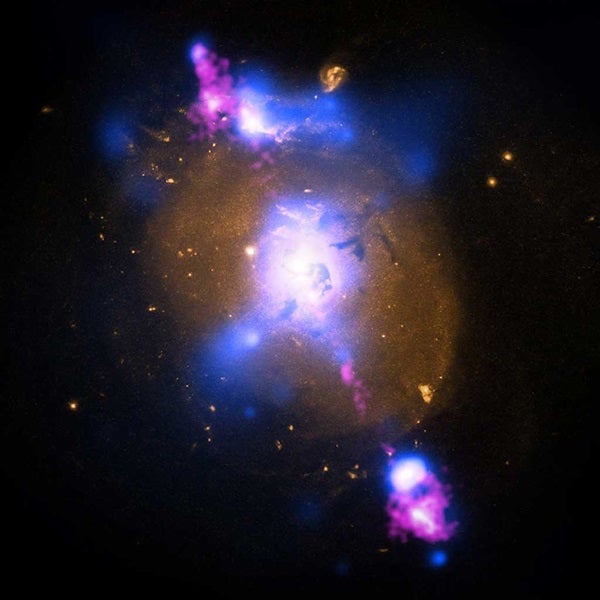This multiwavelength view shows 4C+29.30, a galaxy located some 850 million light-years from Earth. The radio emission comes from two jets of particles that are speeding at millions of miles per hour away from a supermassive black hole at the center of the galaxy. The estimated mass of the black hole is about 100 million times the mass of our Sun. The ends of the jets show larger areas of radio emission located outside the galaxy.
The X-ray data show a different aspect of this galaxy, tracing the location of hot gas. The bright X-rays in the center of the image mark a pool of million-degree gas around the black hole. Some of this material may eventually be consumed by the black hole, and the magnetized whirlpool of gas near the black hole could, in turn, trigger more output to the radio jet.
Most of the low-energy X-rays from the vicinity of the black hole are absorbed by dust and gas, probably in the shape of a giant doughnut around the black hole. This doughnut, or torus, blocks all the optical light produced near the black hole, so astronomers refer to this type of source as a hidden or buried black hole. The optical light seen in the image is from the stars in the galaxy.
The bright spots in X-ray and radio emission on the outer edges of the galaxy, near the ends of the jets, are caused by extremely high-energy electrons following curved paths around magnetic field lines. They show where a jet generated by the black hole has plowed into clumps of material in the galaxy. Much of the energy of the jet goes into heating the gas in these clumps, and some of it goes into dragging cool gas along the direction of the jet. Both the heating and the dragging can limit the fuel supply for the supermassive black hole, leading to temporary starvation and stopping its growth. This feedback process is thought to cause the observed correlation between the mass of the supermassive black hole and the combined mass of the stars in the central region, or bulge, of a galaxy.










